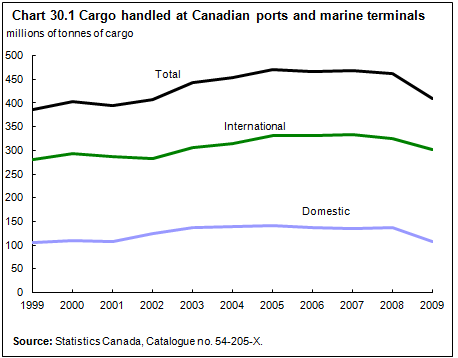Transportation
Archived Content
Information identified as archived is provided for reference, research or recordkeeping purposes. It is not subject to the Government of Canada Web Standards and has not been altered or updated since it was archived. Please "contact us" to request a format other than those available.
Related information
As the second-largest country on earth, with a population stretched from coast to coast to coast, Canada faces unique transportation challenges. As a result, the transportation industry remains a significant force in the Canadian economy, representing 4.7% of the gross domestic product (GDP).
In 2010, transportation and warehousing GDP advanced 4.3%, ahead of the 3.3% growth posted by the whole economy. Rail transportation gained the most ground, increasing 11.8% and contributing $5.4 billion, as railways carried 291.3 million tonnes of freight, up 12.2% in 2009. Truck transportation, the largest component of transportation GDP, contributed $17.1 billion and represented 29.3% of overall transportation and warehousing GDP. All transportation and warehousing industries gained in 2010 with the exception of pipeline transportation, which fell 6.9%, but still produced $4.2 billion worth of GDP.
From 2000 to 2010, transportation GDP expanded 16.3%, to reach $58.4 billion. The decade saw GDP growth in air (18.6%), rail (7.7%) and truck (25.9%) transportation, whereas marine transportation declined (16.6%).
Marine shipping activity declines
In 2009, Canada's ports and marine terminals handled 409.1 million tonnes of cargo, down 11.8% from 2008, as the volume of both domestic and international cargo declined. The largest decline in shipments during the year occurred at the port of Nanticoke in Southern Ontario, where the tonnage dropped 8.4 million tonnes.
The amount of total domestic cargo handled fell 22.2% to 107.4 million tonnes. International cargo declined for the second consecutive year, decreasing 7.4% to 301.7 million tonnes. Regionally, the largest decreases in international cargo were in shipments originating from the Great Lakes of the United States (down 12.4 million tonnes) followed by shipments destined for Europe (down 7.4 million tonnes).
After several years of growth, international containerized cargo declined in both volume (11.8%) and tonnage (7.9%). In 2009, Canadian ports handled 3.9 million twenty-foot equivalent units of containers and 34.8 million tonnes of international containerized cargo.
Port Metro Vancouver is still the country's leading port in the handling of containerized traffic; it handled 55% of the total container volume in 2009.
Resource commodities were among the cargo that showed sharp declines in shipments. Most notable were coal, iron ores and concentrates, crude petroleum and potash—together these accounted for 50% of the decline in marine shipping in 2009. Crude petroleum remains the single largest commodity handled within the Canadian marine transportation system, representing more than 20% of the total tonnage.
Canadians are driving more
The number of Canadian road motor vehicle registrations increased by 12% from 2004 to 2009, reaching a total of 21 million vehicles. As the number of vehicles on the roads increased over the course of the 20th century, the number of people per vehicle declined. There were 8.6 people for each vehicle registered in 1931; by the mid-1980s, this number had fallen to 1.7 people per vehicle.
Canadians drove more in 2009, with total kilometres driven rising 2.4% from 2008 to reach 333.3 billion kilometres, or 16,249 kilometres per Canadian. The number of vehicles on the road also increased in 2009, up 1.7% from 2008. Across the country, driving to work is by far the most popular commuting method.
Employment declines
Many Canadians make their living moving people and goods around the country. In 2010, transportation and warehousing industries employed 670,675 Canadians. Payroll employment in transportation slipped 0.9% in 2010, the second consecutive annual decline. Payroll employment in air (-1.8%) and rail (-5.6%) transportation declined, whereas support activities for transportation advanced 1.4%. Employment in trucking declined 0.8%, though it still employed a quarter of those in the transportation and warehousing industries.
From 2000 to 2010, payroll employment in transportation increased 11.9%. Truck transportation, the transportation industry's largest employer, increased the number of employees on payroll by 6.2% over the decade to a total of 166,932. Payroll employment in the rail industry shrank steadily over the decade for a cumulative decline of 26.3%.
- Date modified:

